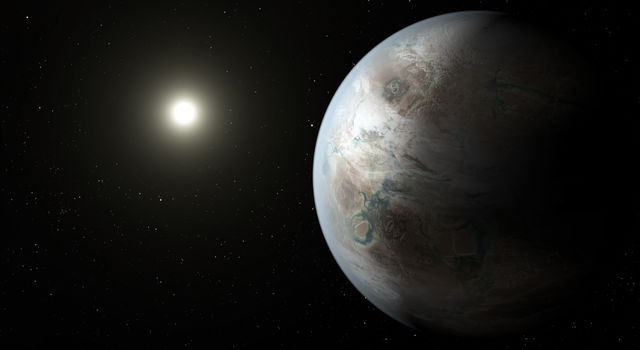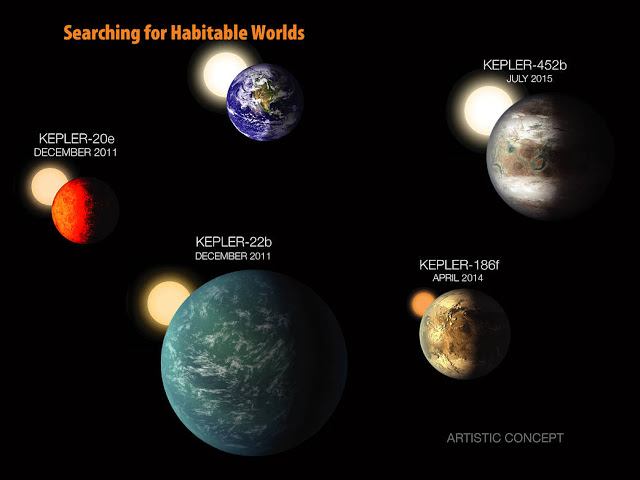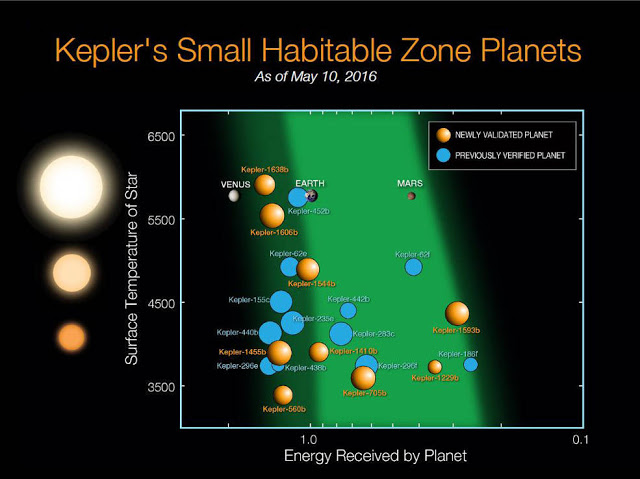

| Online: | |
| Visits: | |
| Stories: |

| Story Views | |
| Now: | |
| Last Hour: | |
| Last 24 Hours: | |
| Total: | |
Volcanic Hydrogen Helps Chances of Finding Extraterrestrial Life on Exoplanets
NASA’s Kepler mission has confirmed 3458 exoplanets to date.
Hunting for habitable exoplanets now may be easier: Cornell University astronomers report that hydrogen pouring from volcanic sources on planets throughout the universe could improve the chances of locating life in the cosmos.
Planets located great distances from stars freeze over. “On frozen planets, any potential life would be buried under layers of ice, which would make it really hard to spot with telescopes,” said lead author Ramses Ramirez, research associate at Cornell’s Carl Sagan Institute. “But if the surface is warm enough – thanks to volcanic hydrogen and atmospheric warming – you could have life on the surface, generating a slew of detectable signatures.”
This artist’s concept depicts one possible appearance of the exoplanet Kepler-452b, the first near-Earth-size world to be found in the habitable zone of star that is similar to our sun.

Image credit: NASA Ames/JPL-Caltech/T. Pyle
Their research, “A Volcanic Hydrogen Habitable Zone,” is published in The Astrophysical Journal Letters.
The idea that hydrogen can warm a planet is not new, but an Earth-like planet cannot hold onto its hydrogen for more than a few million years. Volcanoes change the concept. “You get a nice big warming effect from volcanic hydrogen, which is sustainable as long as the volcanoes are intense enough,” said Ramirez, who suggested the possibility that these planets may sustain detectable life on their surface.
A very light gas, hydrogen also “puffs up” planetary atmospheres, which will likely help scientists detect signs of life. “Adding hydrogen to the air of an exoplanet is a good thing if you’re an astronomer trying to observe potential life from a telescope or a space mission. It increases your signal, making it easier to spot the makeup of the atmosphere as compared to planets without hydrogen,” said Ramirez.
In our solar system, the habitable zone extends to 1.67 times the Earth-sun distance, just beyond the orbit of Mars. With volcanically sourced hydrogen on planets, this could extend the solar system’s habitable zone reach to 2.4 times the Earth-sun distance – about where the asteroid belt is located between Mars and Jupiter. This research places a lot of planets that scientists previously thought to be too cold to support detectable life back into play.
Since Kepler launched in 2009, 21 planets less than twice the size of Earth have been discovered in the habitable zones of their stars. The orange spheres represent the nine newly validated planets announcement on May 10, 2016. The blue disks represent the 12 previous known planets. These planets are plotted relative to the temperature of their star and with respect to the amount of energy received from their star in their orbit in Earth units. The sizes of the exoplanets indicate the sizes relative to one another. The images of Earth, Venus and Mars are placed on this diagram for reference. The light and dark green shaded regions indicate the conservative and optimistic habitable zone.
Atmospheric biosignatures, such as methane in combination with ozone – indicating life – will likely be detected by the forthcoming, next-generation James Webb Space Telescope, launching in 2018, or the approaching European Extremely Large Telescope, first light in 2024.
Last week, NASA reported finding seven Earth-like planets around the star Trappist-1. “Finding multiple planets in the habitable zone of their host star is a great discovery because it means that there can be even more potentially habitable planets per star than we thought,” said Kaltenegger. “Finding more rocky planets in the habitable zone – per star – increases our odds of finding life.”
Credit; NASA
With this latest research, Ramirez and Kaltenegger have possibly added to that number by showing that habitats can be found, even those once thought too cold, as long as volcanoes spew enough hydrogen. Such a volcanic hydrogen habitable zone might just make the Trappist-1 system contain four habitable zone planets, instead of three. “Although uncertainties with the orbit of the outermost Trappist-1 planet ‘h’ means that we’ll have to wait and see on that one,” said Kaltenegger.
The Simons Foundation and the Cornell Center for Astrophysics and Planetary Science funded this research.
Rebecca Valli
Source:





